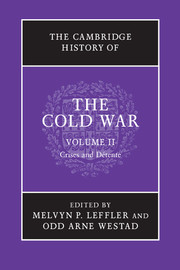Book contents
- Frontmatter
- 1 Grand strategies in the Cold War
- 2 Identity and the Cold War
- 3 Economic aspects of the Cold War, 1962–1975
- 4 The Cuban missile crisis
- 5 Nuclear competition in an era of stalemate, 1963–1975
- 6 US foreign policy from Kennedy to Johnson
- 7 Soviet foreign policy, 1962–1975
- 8 France, “Gaullism,” and the Cold War
- 9 European integration and the Cold War
- 10 Détente in Europe, 1962–1975
- 11 Eastern Europe: Stalinism to Solidarity
- 12 The Cold War and the transformation of the Mediterranean, 1960–1975
- 13 The Cold War in the Third World, 1963–1975
- 14 The Indochina wars and the Cold War, 1945–1975
- 15 The Cold War in the Middle East: Suez crisis to Camp David Accords
- 16 Cuba and the Cold War, 1959–1980
- 17 The Sino-Soviet split
- 18 Détente in the Nixon–Ford years, 1969–1976
- 19 Nuclear proliferation and non-proliferation during the Cold War
- 20 Intelligence in the Cold War
- 21 Reading, viewing, and tuning in to the Cold War
- 22 Counter-cultures: the rebellions against the Cold War order, 1965–1975
- 23 The structure of great power politics, 1963–1975
- 24 The Cold War and the social and economic history of the twentieth century
- Bibliographical essay
- Index
- References
1 - Grand strategies in the Cold War
Published online by Cambridge University Press: 28 September 2010
- Frontmatter
- 1 Grand strategies in the Cold War
- 2 Identity and the Cold War
- 3 Economic aspects of the Cold War, 1962–1975
- 4 The Cuban missile crisis
- 5 Nuclear competition in an era of stalemate, 1963–1975
- 6 US foreign policy from Kennedy to Johnson
- 7 Soviet foreign policy, 1962–1975
- 8 France, “Gaullism,” and the Cold War
- 9 European integration and the Cold War
- 10 Détente in Europe, 1962–1975
- 11 Eastern Europe: Stalinism to Solidarity
- 12 The Cold War and the transformation of the Mediterranean, 1960–1975
- 13 The Cold War in the Third World, 1963–1975
- 14 The Indochina wars and the Cold War, 1945–1975
- 15 The Cold War in the Middle East: Suez crisis to Camp David Accords
- 16 Cuba and the Cold War, 1959–1980
- 17 The Sino-Soviet split
- 18 Détente in the Nixon–Ford years, 1969–1976
- 19 Nuclear proliferation and non-proliferation during the Cold War
- 20 Intelligence in the Cold War
- 21 Reading, viewing, and tuning in to the Cold War
- 22 Counter-cultures: the rebellions against the Cold War order, 1965–1975
- 23 The structure of great power politics, 1963–1975
- 24 The Cold War and the social and economic history of the twentieth century
- Bibliographical essay
- Index
- References
Summary
Wars have been around for a very long time. Grand strategies for fighting wars – if by “grand strategy” one understands the calculated use of available means in the pursuit of desired ends – have probably been around almost as long; but our record of them dates back to only the fifth century BCE when Herodotus and Thucydides set out to chronicle systematically how the great wars of their age had been fought. We do have, however, in the greatest of all poems, mythologized memories of a war fought centuries earlier, none of whose participants appear to have known how to write. But they did know about the need to connect ends with means: “Put heads together,” Homer has wise Nestor admonishing the Achaeans at a desperate moment in the long siege of Troy, “if strategy’s any use.”
The ancient Greeks made no sharp distinction between war and peace. Wars could last for years, even decades; they could pause, however, to allow the sowing and harvesting of crops, or for the conduct of games. The modern state system, which dates from the seventeenth century, was meant to stake out boundaries that did not exist in the era of Homer, Herodotus, and Thucydides: nations were either to be at war or they were not. But the boundaries blurred again during the Cold War, a struggle that went on longer than the Trojan, Persian, and Peloponnesian wars put together. The stakes, to be sure, were higher. The geographical scope of the competition was much wider.
- Type
- Chapter
- Information
- The Cambridge History of the Cold War , pp. 1 - 21Publisher: Cambridge University PressPrint publication year: 2010
References
- 2
- Cited by

